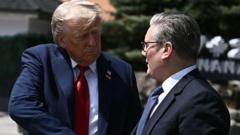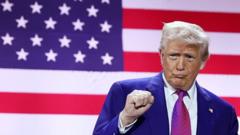The ongoing trade war between the US and China is marked by heavy tariffs and economic uncertainty. With a vast domestic market, investment in high-tech industries, and control over critical rare earth elements, China demonstrates resilience and determination in resisting American pressures. Analysts suggest that while the US may seek to isolate China economically, the Asian giant's diversified trade partnerships and strategic resources present formidable challenges.
China's Strategic Maneuvers in the Ongoing Trade War with the US

China's Strategic Maneuvers in the Ongoing Trade War with the US
As trade tensions escalate, China prepares for a protracted economic battle with the United States, leveraging its unique resources and strategic advantages.
The trade war between the United States and China is intensifying, showcasing a complex interplay of economic strategies. Currently, Chinese products exported to the US are subjected to tariffs as high as 245%, while Beijing has retaliated with 125% tariffs on American imports. As markets brace for potential downturns and consumers grapple with rising prices, the specter of a global recession looms larger. Chinese President Xi Jinping’s administration has expressed readiness for dialogue but emphasizes a willingness to "fight to the end" if necessary, indicating a protracted standoff.
China's resilience in this trade conflict is evident, given its position as the second-largest economy globally, which allows it to buffer the economic shock of tariffs better than smaller nations. An expansive domestic market of over a billion consumers could provide some relief for exporters facing the pressures of punitive tariffs. While the Chinese populace is currently hesitant to spend, government initiatives aimed at stimulating consumption could significantly shift the landscape. Trade expert Mary Lovely highlighted that the Chinese Communist Party may endure economic discomfort to resist what it perceives as American aggression.
Unlike democratic nations, the Chinese government holds a unique advantage in its ability to prioritize long-term stability over immediate public opinion. This authoritarian structure minimizes the political repercussions of economic hardship, despite underlying concerns about social unrest exacerbated by existing economic dilemmas, including property market instability and unemployment.
China's commitment to innovation is another pivotal asset. The government has allocated substantial investments toward emerging sectors like artificial intelligence and electric vehicles, positioning itself as a competitive force in the global technology arena. This initiative aligns with a broader objective to reduce dependency on foreign tech by fostering a home-grown industrial ecosystem. The Chinese economy is increasingly diversifying; for example, trade partnerships with Southeast Asia and Latin America have grown, making these regions key trade allies.
Since the onset of Trump-era tariffs in 2018, China has recalibrated its trade strategies, redirecting dependency from American sources. For instance, imports of US soybeans dropped from 40% to around 20% as Beijing bolstered local agriculture and established stronger ties with Brazil. This diversification strategy not only diminishes reliance on US agricultural exports but also enhances China's food security.
Trade analysts note that the US remains a vital trading partner for China, yet not the only one. China's recent economic statistics showcase that 2023 saw the nation emerge as the top trading partner for 60 countries. In major shifts, Southeast Asia has overtaken the US as China's largest export market. However, with Washington indicating plans to isolate China through trade negotiations, Beijing has issued warnings against agreements that might undermine its interests, presenting an increasingly complex global trade environment.
Furthermore, the situation regarding US government bonds illustrates the high-stakes dynamics of the trade war. While past tariffs from Trump led to a significant sell-off in the bond market, resulting in fears and shifts in financial strategies, commentators suggest China holds considerable influence over US bonds and might leverage this as economic pressure. However, such measures could backfire, potentially destabilizing China's economic landscape as well.
China's dominance in the rare earth elements market represents its strategic leverage point in this trade conflict. With essential resources for advanced manufacturing, including semiconductors and renewable energy technologies, China’s control over approximately 61% of rare earth production and 92% of refining creates a critical dependency for international industries, including defense. As tensions rise, China's recent restrictions on exporting rare earth materials signal its readiness to utilize this advantage, implicating significant risk for the US and its allies.
In summary, while the US seeks to maneuver economically against China, the latter’s robust internal market, strategic investments, diversified trade partnerships, and pivotal control over rare earths complicate Washington's approach. The complexities of this trade war reveal a nuanced battle where both sides must navigate significant geopolitical and economic landscapes.






















